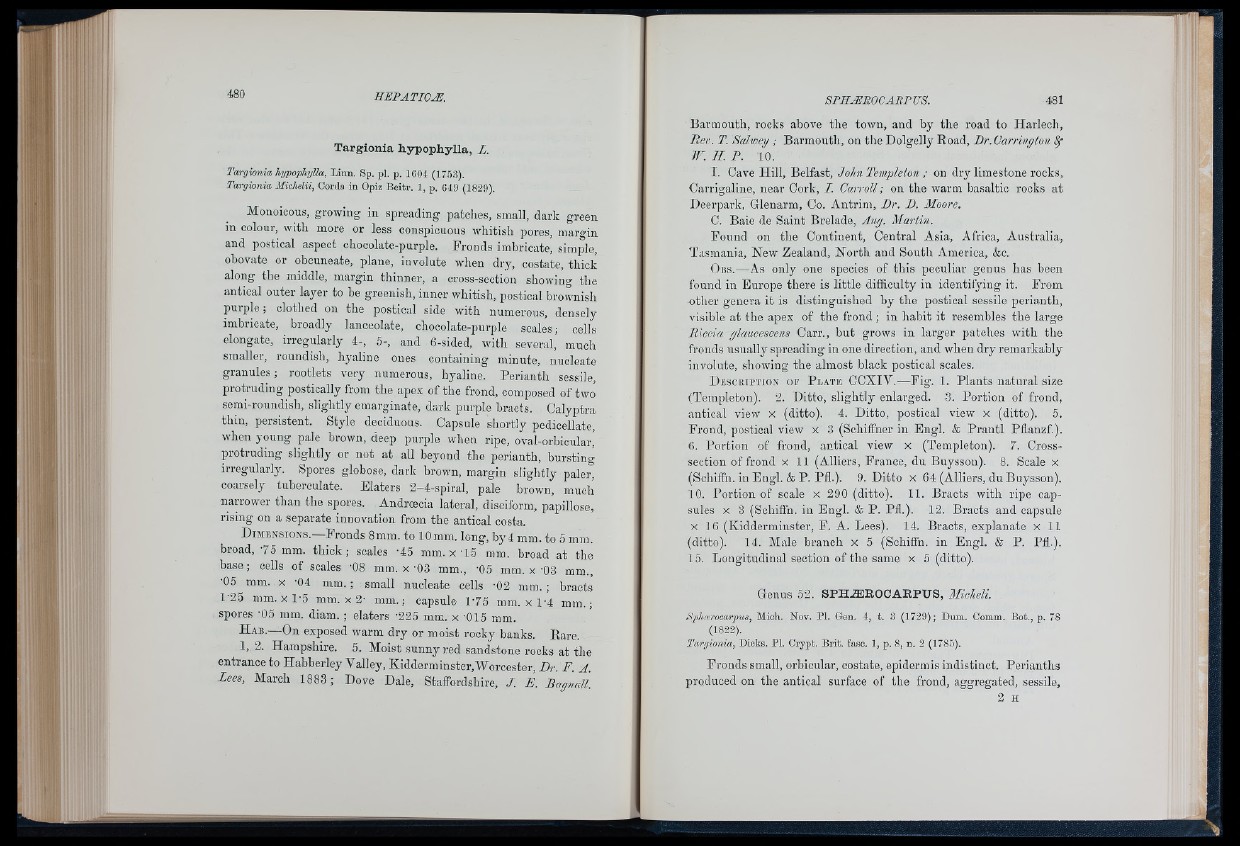
Targionia hypophylla, L.
Targionia hypophylla, Linn. Sp. pl. p. 1604 (17.53).
Targionia Michdii, Corda in Opiz Beitr. 1, p. 649 (1829),
Monoicous, growing in spreading patches, small, dark green
in colour, with more or less conspicuous whitisli pores, margin
and postical aspect chocolate-purple. Fronds imbricate, simple,
obovate or obcuneate, plane, involute when dry, costate, thick
along the middle, margin thinner, a cross-section showing the
antical outer layer to be greenish, inner whitish, postical brownish
purple; clothed on the postical side with numerous, densely
imbrioate, broadly lanceolate, chocolate-purple scales; cells
elongate, irregularly 4-, 5-, and 6-sided, with several, much
smaller, roundish, hyaline ones containing minute, nucleate
granules; rootlets very numerous, hyaline. Perianth sessile,
protruding postically from the apex of the frond, composed of two
semi-roundish, slightly emarginate, dark purple bracts. Calyptra
thin, persistent. Style deciduous. Capsule shortly pedicellate,
when young pale brown, deep purple when ripe, oval-orbicular,’
protruding slightly or not at all beyond the perianth, bursting
irregularly. Spores globose, dark brown, margin slightly paler,
coarsely tuberculate. Elaters 2-4-spiral, pale brown, much
narrower than the spores. Androecia lateral, disciform, papillose,
rising on a separate innovation from the antical costa.
D im ens ions .— Fronds 8mm. to 10mm. long, h y 4 mm. to 5 mm.
broad, 7 5 mm. th ick ; scales -45 mm. x T5 mm. broad at the
base ; cells o f scales ‘08 mra. x '03 mm., '05 mm. x '03 mm.,
•05 mm. X '04 mm. ; small nucleate cells -02 mm. ; bracts
1-25 mm. X 1-5 mm. x 2- mm.; capsule 1'75 mm. x l ' 4 mm. ;
spores -05 mm. diam. ; elaters -225 mm. x '015 mm.
H ab.— On exposed warm dry or moist rooky banks. Rare.
1, 2. Hampshire. 5. Moist sunny red sandstone rooks at the
entrance to Habberley Valley, Kidderminster,Worcester. Br. F. A
Lees, March 1883 ; Dove Dale, Staffordshire, .1 E Bagnall
I b
Barmouth, rooks above the town, and by the road to Harlech,
liev. T. Salweg ; Barmouth, on the Dolgelly Road, Dr. Carrington fl
W. I I P. 10.
I. Cave Hill, Belfast, John Temqdeton ; on dry limestone rocks,
Carrigaline, near Cork, I. Carroll ; on the warm basaltic rocks at
Deerpark, Glenarm, Co. Antrim, Dr. D. Moore.
C. Baie de Saint Brelade, Aug. Martin.
Found on the Continent, Central Asia, Africa, Australia,
Tasmania, New Zealand, North and South America, &o.
O b s .— As only one species of this peculiar genus has been
found in Europe there is little difficulty in identifying it. From
other genera it is distinguished by the postical sessile perianth,
visible at the apex of the frond ; in habit it resembles the large
Miccia glaucescens Carr., but grows in larger patches with the
fronds usually spreading in one direction, and when dry remarkably
involute, sliowing the almost black postical scales.
D escription oe P late CCXIV.—Fig. 1. Plants natural size
(Templeton). 2. Ditto, slightly enlarged. 3. Portion of frond,
antical view x (ditto). 4. Ditto, postical view x (ditto). 5.
Frond, postical view x 3 (Sohiffner in Engl. & Prantl Pflanzf.).
6. Portion of frond, antical view x (Templeton). 7. Cross-
section of frond x 11 (Alliers, France, du Buysson). 8. Scale x
(Schiffn. in Engl. & P. Pfl.). 9. Ditto x 64 (Alliers, du Buysson).
10. Portion of scale x 290 (ditto). 11. Bracts with ripe capsules
X 3 (Schiffn. in Engl. & P. Pfl.). 12. Bracts and capsule
X 16 (Kidderminster, F. A. Lees). 14. Bracts, explanate x 11
(ditto). 14. Male branch x 5 (Schiffn. in Engl. & P. PH.).
15. Longitudinal section of the same x 5 (ditto).
Genus 52. SPH-ffiROCARPUS, Micheli.
Spharoearpns, Mioh. Nov. PI. Gen. 4, t. 3 (1729); Dum. Comm. Bot,, p. 78
(1822).
Targionia, Dioks, PI. Crypt. Brit. fasc. 1, p. 8, n. 2 (1785).
Fronds small, orbicular, costate, epidermis indistinct. Perianths
produced on the antioal surface of the frond, aggregated, sessile,
2 H